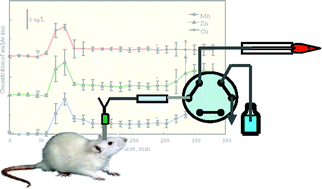Little is known about the in vivo kinetics of trace metal ions in the brain during various neurodegenerative events. In this paper, we describe a method for simultaneously monitoring the kinetics of several trace metal ions in vivo in brain extracellular fluid using microdialysis coupled online with in-tube solid phase extraction (SPE) and ICP-MS detection. To facilitate the online selective separation and ICP-MS detection processes, the trace metal ions in the dialysates, which contained tremendous amounts of salt matrix, were extracted online on the inner wall of a PVC tube—modified with a conditioning solution (10 mg EDTA L–1 of pH 10) in advance—and delivered to the ICP-MS using an eluent containing 20 mg L–1 of EDTA at pH 10. Coupling of the microdialysis sampling with the online in-tube SPE and ICP-MS detection allowed us to measure simultaneously the changes in the concentrations of Zn2+, Cu2+, and Mn2+ in the brain extracellular fluid over time. Using our proposed in-tube SPE process, we obtained online detection limits that were in the sub-microgram-per-litre range (based on 3σ); the temporal resolution was limited to 15 min because of the very low microdialysis perfusion rate (0.5 µL min–1). By combining with microdialysis probe, we also found the long-term stability of the continuous measurement over 5 h of each of the analyte ions was within 10% CV and there was no significant change in the recoveries of analyte ions when using the same PVC tubing with our online system to measure analyte ions at 10 µg L–1. From animal experiments we determined that the basal concentrations of Cu2+, Zn2+, and Mn2+ were 2.19 ± 0.12, 4.07 ± 1.81, and 2.74 ± 0.11 µg L–1, respectively; these values agree well with those found in the literature. Additionally, we observed apparent increases in the levels of zinc and manganese in the extracellular fluid of the brain in vivo after administering MnSO4, ZnSO4, and CuCl2 through intraperitoneal injection. We verified the reliability of this method by analyzing reference urine samples. To the best of our knowledge, our proposed online analytical system is the first example of a minimally invasive technique that is capable of simultaneously investigating the transfer kinetics of several metal ions in the brain in vivo.


 Please wait while we load your content...
Please wait while we load your content...